Top 10 Places to Visit in Paris
Paris, the City of Light, is a dream destination for travelers worldwide. Known for its romantic charm, iconic landmarks, and cultural treasures, it offers an unforgettable experience for every visitor. This guide covers the Top 10 Places to Visit in Paris, along with the best times to go and why they should be on your must-see list.
1. Eiffel Tower: The Icon of Paris 🌟
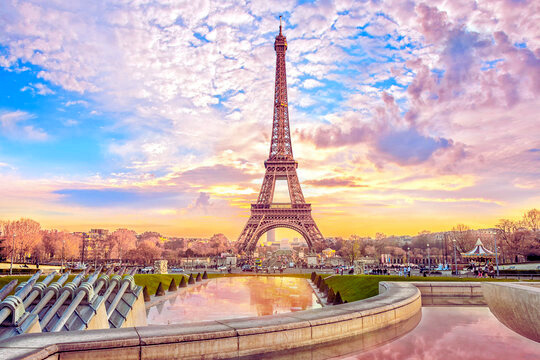
The Eiffel Tower (La Tour Eiffel) is one of the most recognizable landmarks in the world, symbolizing Paris and France as a whole. Standing tall on the banks of the Seine River in the heart of the city, this masterpiece of ironwork is a must-visit for travelers from all corners of the globe.
Key Facts About the Eiffel Tower
- Location: Champ de Mars, 7th arrondissement, Paris, France.
- Height: 330 meters (1,083 feet) after the addition of antennas, making it the tallest structure in Paris.
- Architect: Designed by Gustave Eiffel and completed in 1889 for the World’s Fair (Exposition Universelle).
- Material: Constructed using 18,038 iron parts and weighing over 10,000 tons.
- Nicknames: Often called “The Iron Lady” (La Dame de Fer).
Why Visit the Eiffel Tower?
Stunning Views:
Climb to the top for panoramic views of Paris, including landmarks like the Seine River, Notre Dame Cathedral, and Sacré-Cœur.Architectural Marvel:
A revolutionary design for its time, it showcases the beauty of wrought iron and engineering ingenuity.Romantic Vibes:
Its sparkling lights at night create an unforgettable romantic atmosphere, perfect for couples.Cultural Significance:
The Eiffel Tower is an enduring symbol of French innovation and pride.
Best Time to Visit
- Daytime: Enjoy clear views of Paris and capture stunning photos.
- Evening: Experience the magic of the Eiffel Tower illuminated with golden lights, sparkling for 5 minutes every hour after sunset.
Tips for Visiting
- Book Tickets in Advance: Avoid long queues by purchasing skip-the-line tickets online.
- Explore All Levels:
- First Floor: Features a glass floor and interactive exhibits.
- Second Floor: Offers breathtaking views and fine dining at Le Jules Verne restaurant.
- Top Level: Reach the summit for unmatched panoramic views.
- Capture Memories: The Trocadéro Gardens provide the best spot for iconic photos.
Did You Know?
- The Eiffel Tower was initially criticized by Parisian artists and writers who called it an “eyesore.” Today, it attracts over 7 million visitors annually.
- During World War II, the lift cables were cut to prevent enemy access, forcing anyone who wanted to climb it to use the stairs!
2. Louvre Museum: A Timeless Icon of Art and History
The Louvre Museum in Paris, France, is one of the world’s most renowned and visited art museums. It is a must-see destination for art enthusiasts, history buffs, and travelers seeking to immerse themselves in centuries of creativity and culture. Here’s an in-depth look at this iconic institution:
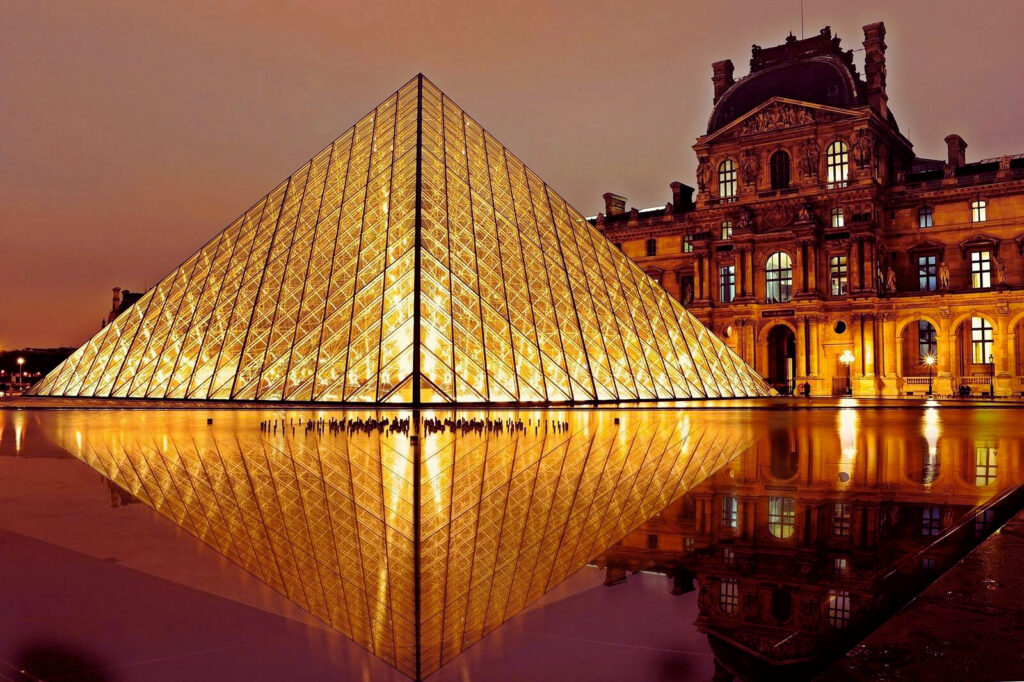
Historical Significance
Originally built as a fortress in the late 12th century, the Louvre transitioned into a royal palace in the 16th century before becoming a public museum in 1793 during the French Revolution. Its rich history is woven into the very structure of the museum, with remnants of the medieval fortress still visible in the lower levels.
Architecture
The Louvre is a blend of classical and modern architecture, featuring:
- Palatial Grandeur: The sprawling building surrounds a central courtyard, adorned with intricate details and sculptures.
- Glass Pyramid: Designed by architect I. M. Pei, the glass pyramid entrance (added in 1989) is a strikingly modern contrast to the historic palace and is an iconic symbol of the Louvre today.
Art Collection
The Louvre boasts over 35,000 works of art displayed across its vast galleries. These works span multiple civilizations and art movements, including:
1. Masterpieces
- Mona Lisa by Leonardo da Vinci: Arguably the museum’s most famous piece, this enigmatic portrait attracts millions of visitors annually.
- Venus de Milo: An ancient Greek statue believed to represent Aphrodite, the goddess of love and beauty.
- The Winged Victory of Samothrace: A stunning marble sculpture of the Greek goddess Nike.
2. Diverse Artifacts
- Egyptian Antiquities: Mummies, sarcophagi, and relics that offer a glimpse into ancient Egyptian civilization.
- Mesopotamian Art: Highlights include the Code of Hammurabi and large Assyrian reliefs.
- Renaissance Art: Works by Michelangelo, Raphael, and Botticelli.
Visitor Experience
- Hours of Exploration: With its vast collection, a single day isn’t enough to see everything. Visitors often focus on highlights or specific sections.
- Audio Guides and Tours: Available for those seeking deeper insights into the museum’s treasures.
- Nearby Attractions: Located in the heart of Paris, the Louvre is close to the Tuileries Garden and Seine River, making it a perfect stop in a larger exploration of the city.
Tips for Visitors
- Book Tickets Online: Avoid long queues by purchasing timed-entry tickets in advance.
- Visit Early or Late: Beat the crowds by arriving when the museum opens or exploring during evening hours.
- Wear Comfortable Shoes: The museum covers over 72,000 square meters of exhibit space, so be prepared to walk!
- Plan Your Visit: Decide which galleries or artworks you want to prioritize to make the most of your time.
Why Visit the Louvre Museum?
The Louvre is more than just a museum; it’s a journey through humanity’s artistic and cultural achievements. Its unparalleled collection and iconic architecture make it a landmark you cannot miss when visiting Paris.
Notre-Dame Cathedral: A Timeless Icon of Gothic Architecture
The Notre-Dame Cathedral in Paris is one of the most famous and enduring symbols of Gothic architecture and French heritage. Situated on the Île de la Cité in the Seine River, this masterpiece has been a centerpiece of Parisian history, culture, and spirituality since its construction began in the 12th century. Despite a devastating fire in April 2019, the cathedral remains a beacon of architectural brilliance and continues to inspire millions around the world.
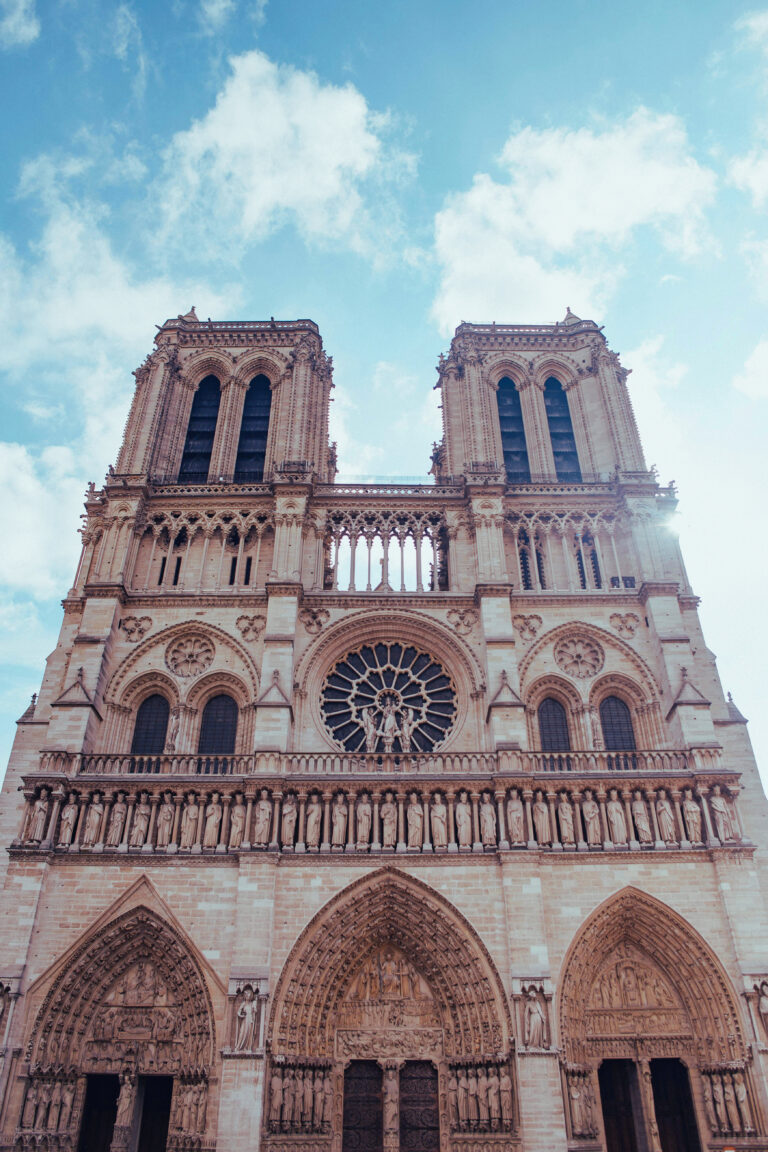
Historical Significance
- Construction Timeline: Began in 1163 and was largely completed by 1345, taking nearly 200 years.
- Cultural Importance: The cathedral has been the site of significant historical events, including Napoleon Bonaparte’s coronation as emperor and the beatification of Joan of Arc.
- UNESCO World Heritage Site: Recognized as part of the “Paris, Banks of the Seine” UNESCO listing in 1991.
Architectural Highlights
Gothic Style
Notre-Dame showcases classic Gothic elements, such as pointed arches, ribbed vaults, and flying buttresses, which give it both grandeur and structural stability.Rose Windows
- The North, South, and West rose windows are stunning examples of medieval stained glass, depicting biblical scenes and saints in intricate detail.
- These windows are celebrated for their vivid colors and extraordinary craftsmanship.
Twin Towers
- The iconic 69-meter twin towers on the western facade offer breathtaking views of Paris.
- Visitors can climb 387 steps to see the city and the cathedral’s famous gargoyles.
Flying Buttresses
- These external supports, especially the large ones on the southern side, are engineering marvels designed to support the massive walls and roof.
Gargoyles and Chimera
- The cathedral’s grotesque gargoyles serve as both decorative elements and functional water spouts.
- The Chimera Gallery, adorned with mythical stone creatures, adds an eerie charm to the facade.
Organ and Bells
- The cathedral houses one of the largest organs in France, featuring 8,000 pipes.
- Its bells, including the famous Emmanuel Bell, have been tolling for centuries during significant events.
Why Visit Notre-Dame Cathedral?
- Architectural Marvel: Witness a masterpiece of human creativity and medieval ingenuity.
- Cultural Treasure: Immerse yourself in centuries of art, history, and faith.
- Panoramic Views: Climb the towers for a stunning view of Paris.
- Spiritual Serenity: Experience the peace and grandeur of a sacred space that has inspired generations.
Notre-Dame’s Restoration Journey
After the 2019 fire that destroyed its spire and severely damaged parts of the roof, efforts have been underway to restore the cathedral to its former glory. Reconstruction aims to maintain the original Gothic design, with a reopening planned for 2024.
4.Basilique du Sacré Coeur de Montmartre:: A Parisian Marvel
The Basilique du Sacré-Cœur, or Basilica of the Sacred Heart, is one of Paris’s most iconic landmarks, perched atop the highest point of the city in the charming neighborhood of Montmartre. Its striking white domes and panoramic views make it a must-visit destination for both art lovers and history enthusiasts.
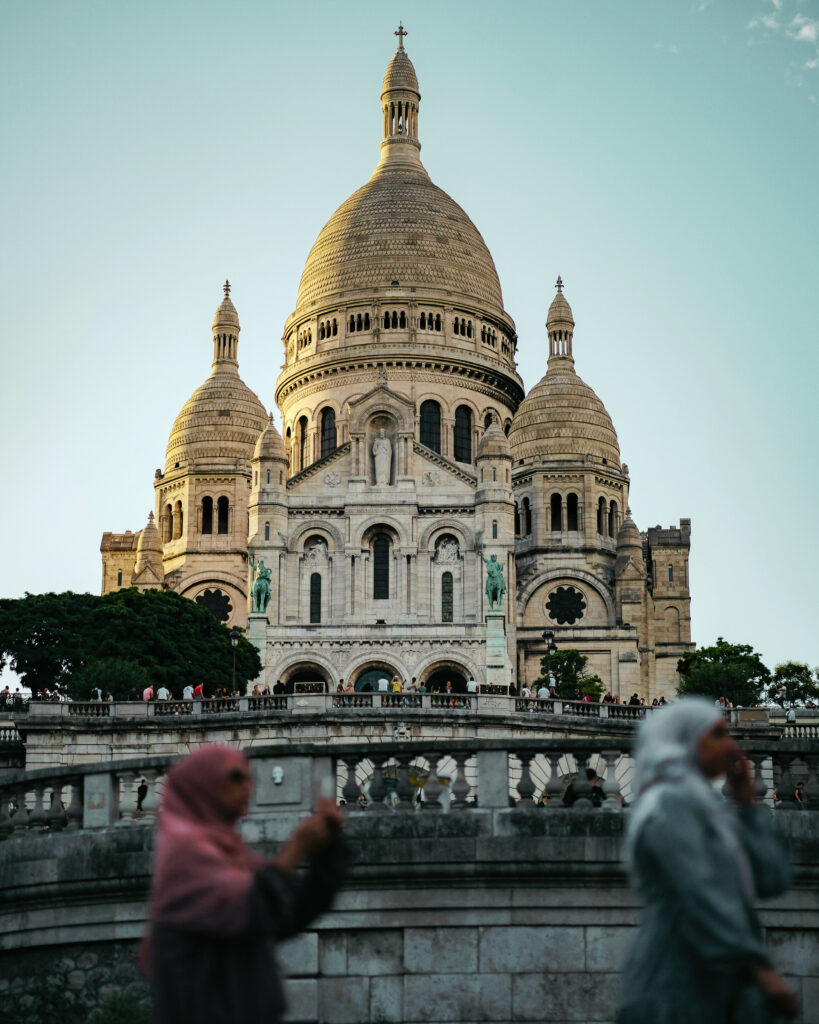
History and Significance
- Built between 1875 and 1914, the basilica was conceived as a symbol of hope and penance following the Franco-Prussian War.
- It was designed by architect Paul Abadie, blending Romanesque and Byzantine styles, which gives it a unique architectural identity.
- Dedicated to the Sacred Heart of Jesus, it stands as a religious and cultural monument, welcoming millions of visitors every year.
Architecture
- The white travertine stone used in construction naturally maintains its brilliance, giving the basilica its pristine, luminous appearance.
- The central dome, standing at 83 meters high, offers a magnificent 360-degree view of Paris for those willing to climb its 300 steps.
- Inside, the basilica boasts one of the world’s largest mosaics, depicting Christ in Majesty, covering over 475 square meters.
Why Visit
- Breathtaking Views: From its hilltop location in Montmartre, the basilica offers some of the most stunning views of Paris.
- Cultural Experience: Montmartre’s artistic streets are filled with quaint cafes, galleries, and street performers, making it a lively area to explore.
- Spiritual Serenity: The basilica remains an active place of worship, offering a peaceful retreat from the bustling city.
Visiting Information
- Opening Hours: Open daily from 6:00 AM to 10:30 PM.
- Entry Fee: Entry to the basilica is free, but there’s a small fee to access the dome.
- Best Time to Visit: Early morning or late evening to enjoy a quieter experience and avoid crowds.
Insider Tips
- Climb the Dome: The view from the top is worth the effort, offering unobstructed vistas of iconic landmarks like the Eiffel Tower.
- Explore Montmartre: Take a stroll around Place du Tertre, where local artists sell their work.
- Attend a Service: Experience the beauty of the basilica’s acoustics by attending a mass or listening to the organ.
5.Arc de Triomphe – A Timeless Icon of Paris
The Arc de Triomphe, located at the western end of the Champs-Élysées in Paris, France, is one of the city’s most iconic monuments. Built to honor those who fought and died for France during the French Revolutionary and Napoleonic Wars, it stands as a symbol of national pride and remembrance.
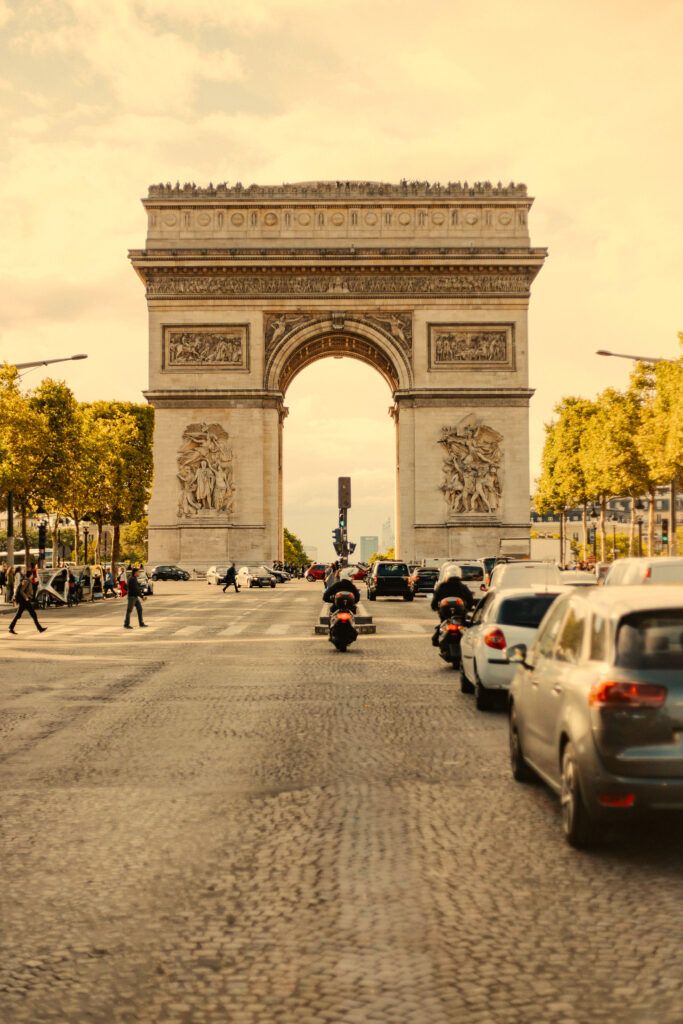
Key Facts
- Commissioned by: Napoleon Bonaparte in 1806 after his victory at Austerlitz.
- Architectural Style: Neoclassical.
- Height: 50 meters (164 feet).
- Width: 45 meters (148 feet).
- Designer: Jean Chalgrin, later completed by other architects after Chalgrin’s death.
- Inaugurated: July 29, 1836.
Features to Explore
Sculptures and Reliefs
The Arc is adorned with intricate sculptures representing key moments in French history, including:- La Marseillaise (The Departure of the Volunteers) by François Rude.
- The Triumph of 1810 by Jean-Pierre Cortot.
These commemorate the courage and sacrifices of French soldiers.
The Tomb of the Unknown Soldier
Beneath the arch lies the Tomb of the Unknown Soldier, a tribute to unidentified soldiers who died in World War I. The eternal flame, rekindled every evening, symbolizes France’s enduring respect for its fallen heroes.Observation Deck
Visitors can climb 284 steps to the top of the Arc for panoramic views of Paris. The vantage point offers a unique perspective of the Champs-Élysées, Eiffel Tower, and the surrounding cityscape.The Names Engraved
The inner walls of the Arc are inscribed with the names of 660 French generals and major battles fought during Napoleon’s reign.
Interesting Facts
- The Arc was the largest triumphal arch in the world until the Arch of Triumph in Pyongyang, North Korea, was completed in 1982.
- Charles Godefroy famously flew his biplane through the Arc in 1919 as a tribute to World War I aviators.
- It is part of the Axe Historique, a line of monuments and thoroughfares stretching from the Louvre to La Défense.
Best Time to Visit
The Arc de Triomphe is captivating any time of day, but it’s especially magical at night when it’s illuminated. For fewer crowds, visit early in the morning or late evening.
Why Visit the Arc de Triomphe?
The Arc de Triomphe isn’t just an architectural marvel; it’s a gateway into France’s storied past. Its towering presence, historical significance, and breathtaking views make it a must-see for anyone visiting Paris.
6.The Palace of Versailles: A Symbol of Grandeur and History
The Palace of Versailles (Château de Versailles) is one of the most magnificent and historically significant landmarks in France. Located about 20 kilometers (12 miles) southwest of Paris, this UNESCO World Heritage Site is an epitome of opulence, showcasing the grandeur of French Baroque architecture, art, and landscaping.
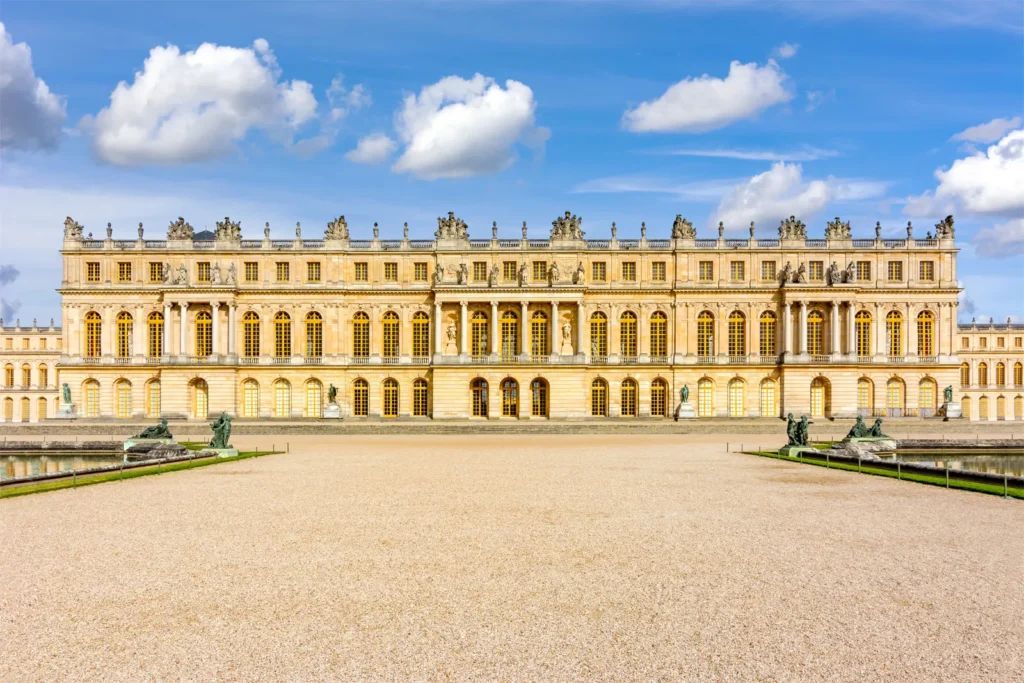
Key Highlights of the Palace
1. Historical Significance
Originally a modest hunting lodge built by King Louis XIII in 1623, Versailles was transformed by his son, Louis XIV, into a grand palace in the 17th century. It became the political and cultural center of France and the seat of absolute monarchy. The palace symbolizes the power and extravagance of the French monarchy until the French Revolution in 1789.
2. Architectural Splendor
The Palace of Versailles is a masterpiece of French Baroque architecture, designed by architects Louis Le Vau and Jules Hardouin-Mansart. Its grandeur is reflected in:
- Ornate Facades: Featuring classical columns, sculptures, and intricate designs.
- Lavish Interiors: Sumptuously decorated with frescoes, gilded moldings, and opulent furnishings.
3. Hall of Mirrors (Galerie des Glaces)
One of the most famous rooms in the palace, the Hall of Mirrors, is a stunning gallery that features:
- 357 intricately designed mirrors reflecting light from large arched windows.
- Crystal chandeliers, gilded sculptures, and a frescoed ceiling depicting the reign of Louis XIV.
This hall also holds historical importance as the location of the signing of the Treaty of Versailles in 1919, marking the end of World War I.
4. The Gardens of Versailles
The sprawling Versailles Gardens, designed by André Le Nôtre, are a marvel of landscaping and symmetry. They cover nearly 800 hectares and feature:
- Manicured Lawns: Intricately designed parterres and flower beds.
- Fountains and Statues: Elaborate water features like the Latona Fountain and the Apollo Fountain.
- The Grand Canal: A 1.6-kilometer waterway perfect for leisurely boat rides.
5. The Estate of Trianon
Separate from the main palace, the Grand Trianon and Petit Trianon served as retreats for the French royals. The Petit Trianon is famously associated with Marie Antoinette, who used it as a private escape from court life.
6. Cultural Legacy
The Palace of Versailles represents the peak of French absolutism and art. Today, it stands as a testament to France’s rich history and is a major tourist attraction, drawing millions of visitors annually.
Visitor Information
- Location: Place d’Armes, 78000 Versailles, France.
- Best Time to Visit: Spring and early autumn (April to October) for pleasant weather and blooming gardens.
- Top Tip: Reserve tickets online to skip long queues and consider taking a guided tour to fully appreciate the palace’s history and details.
7. Seine River Cruise
A Seine River Cruise is one of the most iconic ways to experience the beauty of Paris. Gliding along the river, you’ll be treated to breathtaking views of Paris’ most famous landmarks, such as the Eiffel Tower, Notre Dame Cathedral, and Louvre Museum, all while surrounded by the romantic ambiance of the city.
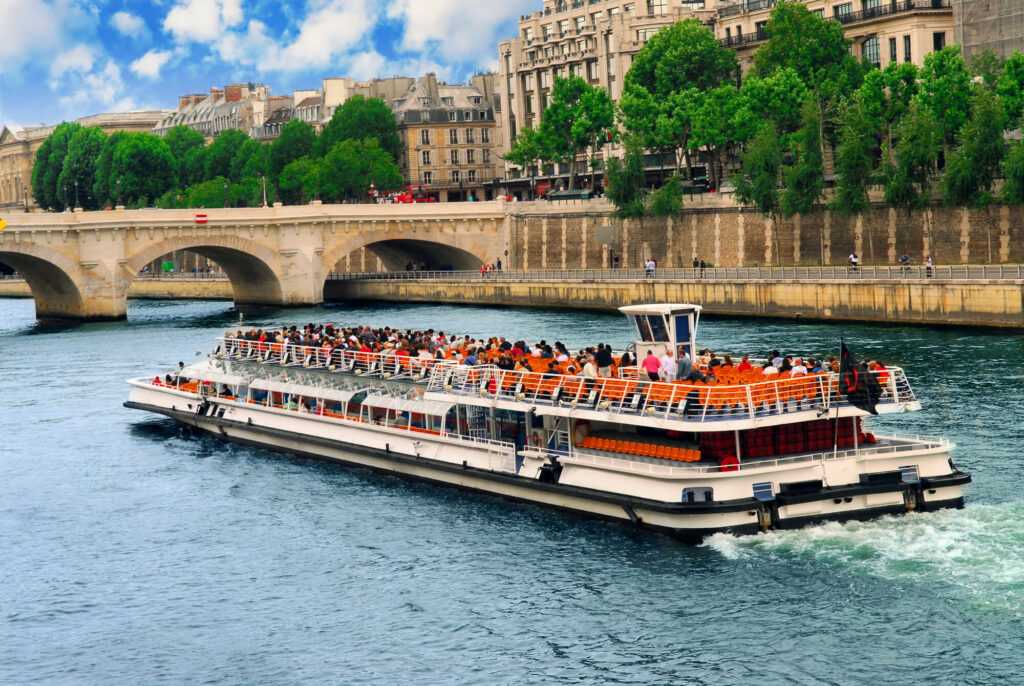
Why Take a Seine River Cruise?
Spectacular Views:
The cruise offers a unique perspective of Paris. As you float down the river, you’ll see many of the city’s most renowned landmarks illuminated by the soft glow of evening lights. The combination of historical architecture and the shimmering waters creates a truly unforgettable experience.
Convenience:
It’s an easy and relaxed way to see many of the city’s highlights without having to navigate the busy streets of Paris. The cruises typically pass under the iconic Pont Neuf and several other beautiful bridges.
Various Options:
There are multiple types of cruises to choose from. For a more romantic experience, consider a dinner cruise where you can enjoy gourmet French cuisine while watching the sunset over the Seine. For a more casual experience, hop on a sightseeing boat with commentary on the city’s history and landmarks.
Timing:
The cruise is wonderful at any time of day, but evening cruises, especially at sunset, are particularly magical. As Paris lights up at night, the view from the river is nothing short of mesmerizing.
A Touch of Romance:
Whether you’re with a loved one, friends, or traveling solo, the serene environment of the Seine River creates the perfect atmosphere for capturing memories.
Best Time to Go
- Spring and Summer: The weather is warmer, and the longer daylight hours make it the perfect time for a scenic sunset or evening cruise.
- Nighttime: The city truly comes alive after dark. Taking a cruise at night lets you see Paris in a new light as all the famous buildings are beautifully lit up.
Overall, a Seine River Cruise is an essential part of any Parisian itinerary, offering both relaxation and breathtaking views of the City of Light!
8. Musée d’Orsay
The Musée d’Orsay is one of Paris’s most iconic museums, located on the banks of the River Seine. Housed in a former Beaux-Arts railway station, Gare d’Orsay, this stunning museum is renowned for its collection of Impressionist and Post-Impressionist masterpieces. Here’s an overview of why you should visit this cultural treasure:
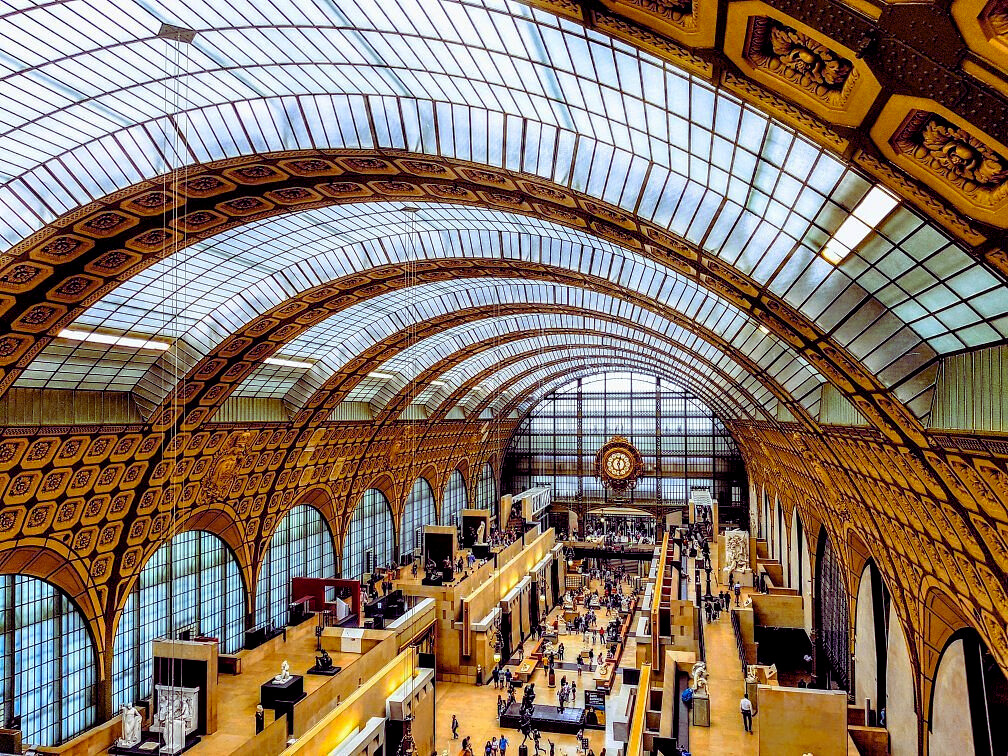
1. A Historical Landmark
The building itself is a masterpiece. Constructed in the 1900s as a railway station for the World’s Fair, it was converted into a museum in 1986, retaining its grand architectural elements like the vast clock and soaring, glass-domed ceiling. The museum’s design combines modern renovations with the original elegance of the train station.
2. Impressionist & Post-Impressionist Art
The museum’s most famous collection showcases works by legendary artists such as:
- Monet, Manet, and Renoir – key figures of Impressionism, known for their revolutionary approach to color and light.
- Van Gogh, Degas, Cézanne, and Gauguin – representing the Post-Impressionist movement that pushed art into bold, new directions.
The paintings, sculptures, and photographs offer an in-depth look at the evolution of modern art from the mid-19th century to the early 20th century.
3. Stunning Art Nouveau Collection
In addition to its painting collection, the museum also features Art Nouveau furniture and design pieces. This unique style, characterized by flowing lines and natural forms, can be admired in the museum’s galleries, blending beautifully with the space’s architecture.
4. Diverse Exhibitions
Beyond its permanent collection, the Musée d’Orsay hosts temporary exhibitions that cover a broad range of art, from contemporary exhibitions to retrospectives of famous artists. These exhibitions allow visitors to experience both classical and modern art in a single visit.
5. Location & Accessibility
Situated between the Tuileries Gardens and the Louvre, the museum is easily accessible on foot from many major Paris attractions. It also offers stunning views of the Seine and the city, making the museum a perfect starting point for exploring the heart of Paris.
6. Why Visit?
- Art Lovers: If you appreciate the history of art and the major shifts in style and technique, the Musée d’Orsay is a must-visit.
- History Enthusiasts: It provides insight into the cultural and historical context of France from the late 19th century to the early 20th century.
- Architectural Beauty: The museum is housed in a former train station that offers an elegant and distinctive environment for art lovers.
Practical Information
- Location: 1 Rue de la Légion d’Honneur, 75007 Paris, France.
- Opening Hours: Tuesday to Sunday, typically from 9:30 AM to 6:00 PM (check for updates).
- Admission: Tickets are generally affordable, with discounts for students and young visitors.
9.Panthéon
The Panthéon is a historic monument located in the Latin Quarter of Paris, France. Originally built as a church, it now serves as a mausoleum housing the remains of some of France’s most distinguished citizens. Here’s a closer look at this iconic structure:
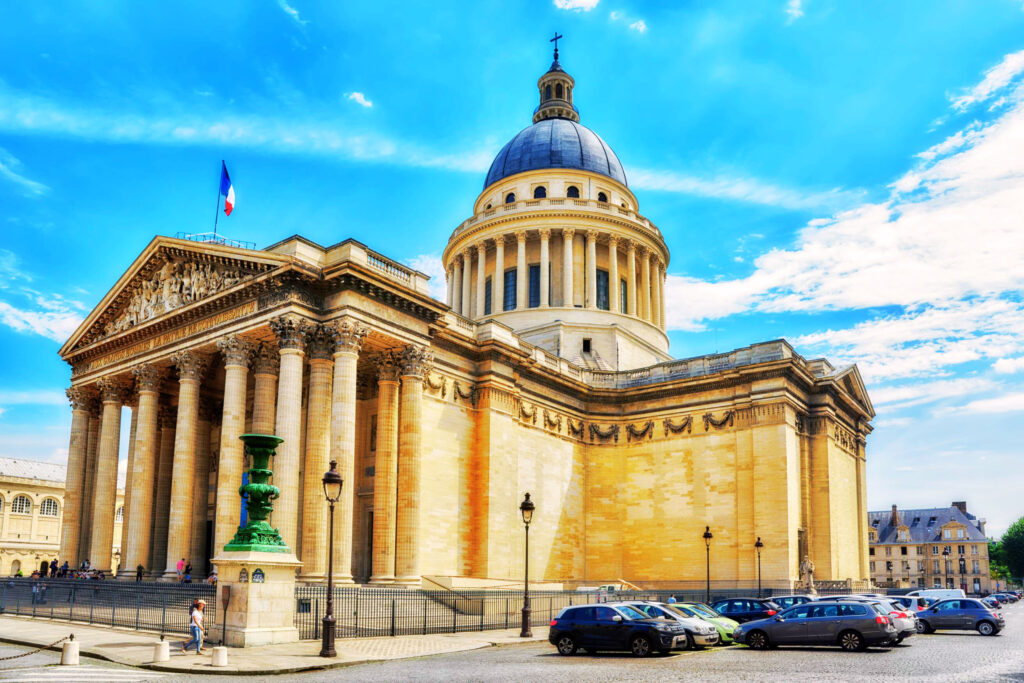
History and Architecture
Construction:
The Panthéon was commissioned by King Louis XV in 1744 and was designed by the architect Jacques-Germain Soufflot. Initially intended as the Church of St. Genevieve, it was later transformed into a national monument during the French Revolution in 1791.
Architectural Style:
The Panthéon is a stunning example of neoclassical architecture, with its grand façade, majestic columns, and a large dome that rises 83 meters (272 feet) above the ground. The design draws inspiration from ancient Roman architecture, particularly the Pantheon in Rome.
Dome:
One of its most striking features is the massive dome, which can be seen from various parts of Paris. The dome is supported by a series of arches, and the interior is equally impressive, with detailed paintings and sculptures.
Significance
A Mausoleum of Greatness:
Today, the Panthéon is a final resting place for some of France’s most celebrated figures, including philosophers like Voltaire and Jean-Jacques Rousseau, scientists like Marie Curie, and political figures like Emile Zola and Louis Braille. The inscription “Aux grands hommes, la patrie reconnaissante” (To the great men, the grateful homeland) is etched on the building, emphasizing its role as a monument to those who contributed significantly to French culture and society.
Symbol of the French Revolution:
The Panthéon also holds symbolic importance due to its transformation from a religious building into a secular national monument during the Revolution. Its role as a symbol of republican values continues to resonate in modern France.
Visiting the Panthéon
Location:
Situated on the Place du Panthéon, it is easily accessible from the Luxembourg Gardens and Sorbonne University.
What to See:
Famous Tombs:
The tombs of renowned individuals are marked by simple yet elegant plaques. Visitors can pay homage to the legendary figures of France’s history.
Interior Artwork:
The ceiling features stunning frescoes, and the walls are adorned with intricate sculptures.
The Crypt:
The crypt beneath the Panthéon houses the tombs and the symbolic resting place of national heroes.
Why Visit?
The Panthéon is not just an architectural masterpiece; it’s a place of reflection on France’s cultural heritage and history. Its combination of art, architecture, and national significance makes it one of Paris’s must-see landmarks for those interested in French history, art, and political legacy.
Fun Fact:
The Panthéon has undergone several restorations over the centuries and even had a brief period when it functioned as a church before becoming a secular monument again in the 19th century.
10. Luxembourg Gardens
The Luxembourg Gardens (Jardin du Luxembourg) in Paris is a beautifully landscaped public park that blends history, natural beauty, and tranquility. Located in the Latin Quarter, the gardens are part of the Luxembourg Palace, which is the seat of the French Senate. Spanning 25 hectares, the gardens are one of Paris’ most beloved green spaces, perfect for relaxation, leisurely strolls, or simply enjoying nature.
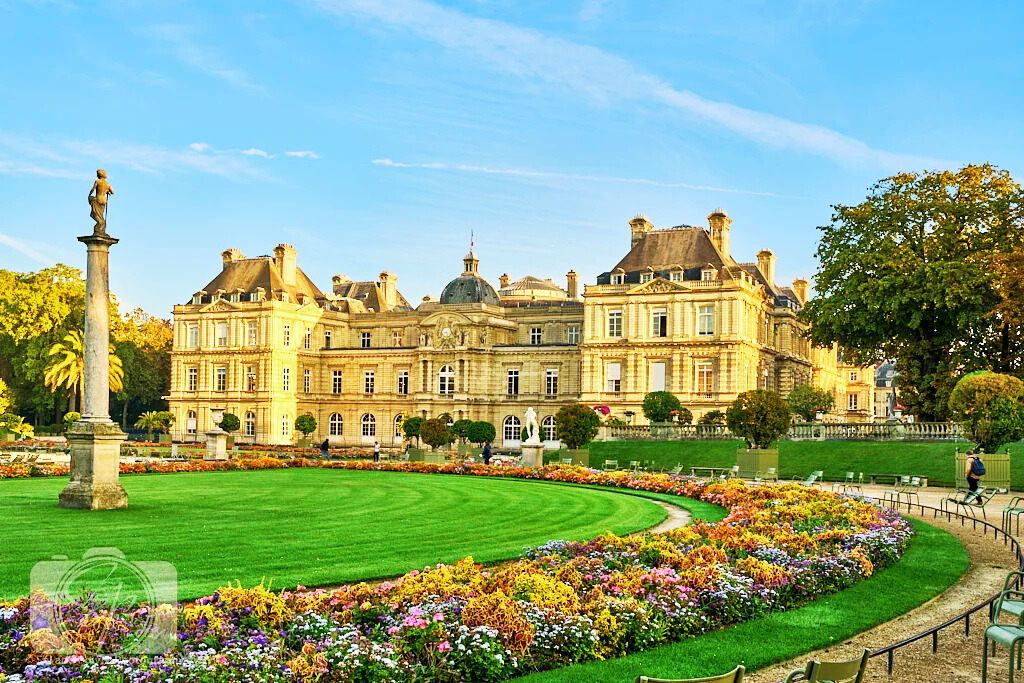
Key Features of Luxembourg Gardens:
Statues and Fountains:
The garden is dotted with over 100 statues, including famous ones like the Statue of Liberty, as well as several beautiful fountains, including the Fountain of the Medici. The grand Octagonal Basin is also a popular feature where visitors can watch children sail small boats.
French and English Gardens:
The park offers a mix of formal French gardens with neatly trimmed hedges and colorful flowerbeds, as well as a more natural, English-style garden with winding paths and a peaceful pond.
The Orangerie:
This charming section of the gardens features a collection of statues and often hosts temporary art exhibitions.
La Fontaine de Medicis:
A romantic and historic spot, this fountain is set in a quiet area surrounded by greenery, with a lovely pond and classical architecture.
Children’s Playground and Puppetry:
The park includes a large playground with swings, climbing structures, and an outdoor puppet theater, making it a great spot for families.
The Sénat:
The Luxembourg Palace, located within the gardens, is home to the French Senate, and while the palace itself is not open to the public, visitors can enjoy the surrounding parkland.
Why Visit Luxembourg Gardens?
Relaxation and Serenity:
It’s an ideal spot to unwind, read a book, or people-watch while surrounded by the lush greenery and flowers.
Scenic Beauty:
The combination of fountains, sculptures, and wide lawns make the park one of the most picturesque places in Paris.
Family-Friendly:
With playgrounds and puppet shows, it’s a great destination for families with children.
Cultural Experience:
The gardens are steeped in history and offer a glimpse into Parisian elegance, from the architecture to the statuary.
Best Time to Visit:
- Spring and Summer: For the full experience, visit when flowers are in bloom, and the weather is perfect for enjoying the outdoor beauty of the gardens.
- Fall: For a quieter experience, the fall months bring a beautiful array of autumn colors, and the crowds are usually thinner.
1 thought on “Top 10 Places to Visit in Paris: The Ultimate Guide for Travelers”